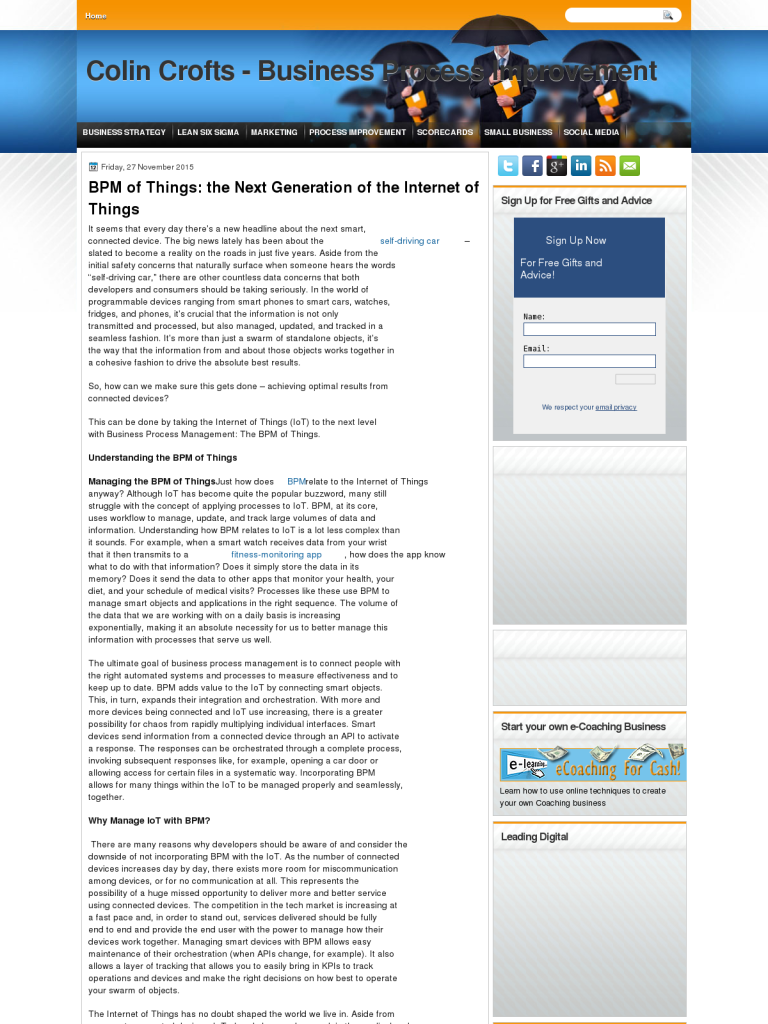BPM of Things: the Next Generation of the Internet of Things
Blog: Colin Crofts - Business Process Improvement
It seems that every day there’s a new headline about the next smart, connected device. The big news lately has been about the self-driving car – slated to become a reality on the roads in just five years. Aside from the initial safety concerns that naturally surface when someone hears the words “self-driving car,” there are other countless data concerns that both developers and consumers should be taking seriously. In the world of programmable devices ranging from smart phones to smart cars, watches, fridges, and phones, it’s crucial that the information is not only transmitted and processed, but also managed, updated, and tracked in a seamless fashion. It’s more than just a swarm of standalone objects, it’s the way that the information from and about those objects works together in a cohesive fashion to drive the absolute best results.
So, how can we make sure this gets done – achieving optimal results from connected devices?
This can be done by taking the Internet of Things (IoT) to the next level with Business Process Management: The BPM of Things.
Understanding the BPM of Things
Managing the BPM of ThingsJust how does BPM relate to the Internet of Things anyway? Although IoT has become quite the popular buzzword, many still struggle with the concept of applying processes to IoT. BPM, at its core, uses workflow to manage, update, and track large volumes of data and information. Understanding how BPM relates to IoT is a lot less complex than it sounds. For example, when a smart watch receives data from your wrist that it then transmits to a fitness-monitoring app, how does the app know what to do with that information? Does it simply store the data in its memory? Does it send the data to other apps that monitor your health, your diet, and your schedule of medical visits? Processes like these use BPM to manage smart objects and applications in the right sequence. The volume of the data that we are working with on a daily basis is increasing exponentially, making it an absolute necessity for us to better manage this information with processes that serve us well.
The ultimate goal of business process management is to connect people with the right automated systems and processes to measure effectiveness and to keep up to date. BPM adds value to the IoT by connecting smart objects. This, in turn, expands their integration and orchestration. With more and more devices being connected and IoT use increasing, there is a greater possibility for chaos from rapidly multiplying individual interfaces. Smart devices send information from a connected device through an API to activate a response. The responses can be orchestrated through a complete process, invoking subsequent responses like, for example, opening a car door or allowing access for certain files in a systematic way. Incorporating BPM allows for many things within the IoT to be managed properly and seamlessly, together.
Why Manage IoT with BPM?
There are many reasons why developers should be aware of and consider the downside of not incorporating BPM with the IoT. As the number of connected devices increases day by day, there exists more room for miscommunication among devices, or for no communication at all. This represents the possibility of a huge missed opportunity to deliver more and better service using connected devices. The competition in the tech market is increasing at a fast pace and, in order to stand out, services delivered should be fully end to end and provide the end user with the power to manage how their devices work together. Managing smart devices with BPM allows easy maintenance of their orchestration (when APIs change, for example). It also allows a layer of tracking that allows you to easily bring in KPIs to track operations and devices and make the right decisions on how best to operate your swarm of objects.
The Internet of Things has no doubt shaped the world we live in. Aside from our smart, connected devices, IoT already has made a mark in the medical and security fields. As society continues to innovate, it is essential to take IoT to the next level and incorporate BPM to direct the flow of massive amounts information these devices collect and share. BPM will turn the Internet of Things into the Internet of Things That Serve Us Well.
Leave a Comment
You must be logged in to post a comment.








